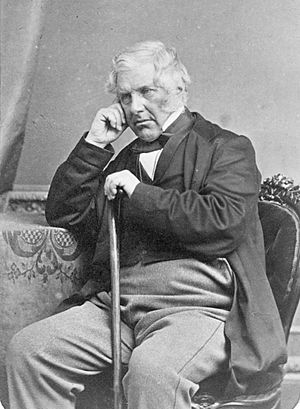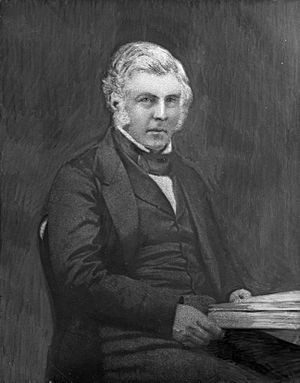Henry Sewell facts for kids
Quick facts for kids
Henry Sewell
|
|
|---|---|

Henry Sewell ca 1872
|
|
| 1st Premier of New Zealand | |
| In office 7 May 1856 – 20 May 1856 |
|
| Monarch | Victoria |
| Governor | Thomas Gore Browne |
| Preceded by | Office established |
| Succeeded by | Sir William Fox |
| 3rd Colonial Secretary of New Zealand | |
| In office 7 May 1856 – 20 May 1856 |
|
| Governor | Thomas Gore Browne |
| New Zealand Legislative Council | |
| In office 1861–1865 |
|
| Personal details | |
| Born | 7 September 1807 Newport, Isle of Wight, England |
| Died | 14 May 1879 (aged 71) Cambridge, Cambridgeshire, England |
| Political party | None |
| Spouses | Lucinda Nedham (m. 1834–1844; her death) Elizabeth Kittoe (m. 1850) |
| Children | 6 |
| Parents | Thomas Sewell Jane Edwards |
| Relatives | Richard (brother) William (brother) James (brother) Elizabeth (sister) |
| Signature | |
Henry Sewell (born 7 September 1807 – died 14 May 1879) was an important politician in New Zealand during the 1800s. He worked hard to help New Zealand gain the right to govern itself. Many people consider him to be New Zealand's very first "Premier," a title that later changed to "Prime Minister." He led a government called the Sewell Ministry in 1856.
After his time as Premier, he also served in other important roles. He was the Colonial Treasurer (like a Finance Minister) from 1856 to 1859, the Attorney-General (the chief legal advisor) from 1861 to 1862, and the Minister of Justice twice (1864–1865 and 1869–1872).
Contents
Henry Sewell's Early Life
Henry Sewell was born on 7 September 1807 in Newport, England. He was the fourth son of Thomas Sewell, who was a lawyer. Henry went to Hyde Abbey School near Winchester and later became a lawyer himself, joining his father's law firm in 1826.
In 1840, his family faced a tough time when a bank failed, causing his father to lose a lot of money. His father died soon after, leaving the family with many debts. In 1844, Henry also lost his first wife, Lucinda, with whom he had six children. To find better opportunities, he moved to London and left his sister in charge of his children and mother.
Henry remarried Elizabeth Kittoe around 1850. They decided to move to New Zealand, hoping for a fresh start and better financial prospects in the new colony.
Joining the Canterbury Association
Henry Sewell became involved with the Canterbury Association. This was a British group focused on setting up a colony in the Canterbury Region of New Zealand. Henry became the Association's deputy director and helped a lot with their plans. The Association faced many problems and debts, but Henry was key in solving these issues.
He arrived in Lyttelton, the port for Christchurch, on 2 February 1853. His goal was to fix the remaining problems of the colony. Despite some disagreements with the local leader, James FitzGerald, Henry successfully helped get the colony back on track.
Henry Sewell's Political Journey
Henry Sewell's personal diary, published as the Sewell Journal, gives a great look into his life in New Zealand. It's considered a very important record of the 1850s.
Entering Parliament
In 1853, Henry decided to run for Parliament in the first New Zealand general election. He chose to run for the Town of Christchurch seat. After some discussions and other candidates stepping aside, Henry Sewell was elected.
| New Zealand Parliament | ||||
| Years | Term | Electorate | Party | |
| 1853–1855 | 1st | Town of Christchurch | Independent | |
| 1855–1856 | 2nd | Town of Christchurch | Independent | |
| 1860 | 2nd | Town of Christchurch | Independent | |
| 1865–1866 | 3rd | Town of New Plymouth | Independent | |
Henry was very skilled in law and finance, which was useful in Parliament. He strongly supported New Zealand governing itself. When the acting Governor, Robert Wynyard, appointed Henry and others to the Executive Council, Henry thought self-government was about to begin. However, when it became clear the Governor saw these appointments as temporary, Henry and his colleagues resigned.
Becoming New Zealand's First Premier
A new Governor, Thomas Gore Browne, later announced that New Zealand would indeed begin self-government with the 2nd New Zealand Parliament. Henry Sewell was elected again. The Governor asked him to form a government, which became known as the Sewell Ministry.
Henry was appointed to the Executive Council on 18 April 1856 and became Colonial Secretary on 7 May. This made him New Zealand's first Premier. His government included Dillon Bell as Colonial Treasurer and Frederick Whitaker as Attorney-General.
However, Henry's government didn't last long. It was seen as too "centralist," meaning it wanted a strong central government rather than strong local governments (provinces). On 20 May 1856, William Fox, who led the "provincialist" group, defeated Sewell's government.
Fox's time as Premier was also short. Edward Stafford, a more moderate politician, soon took over. Stafford invited Henry Sewell to become Colonial Treasurer in his new government. In this role, Henry helped create an important financial agreement between the central government and the provinces.
In late 1856, Henry Sewell left his role as Treasurer and resigned his seat to go back to England. While there, he worked on several deals for New Zealand. He returned to New Zealand in 1859 and briefly became Treasurer again for a month.
In 1860, Henry successfully ran for the Christchurch electorate again. He later resigned to become the Registrar-General of Lands.
Working for Peace with Māori
In 1861, Henry was appointed to the New Zealand Legislative Council, a position he held until 1865.
When fighting began with Māori in 1860 over land issues, Henry Sewell tried to encourage talks and compromise. He believed that conflict could only be solved by having a fair way to buy Māori land, without forcing anyone. He proposed a "Native Council Bill" twice. This bill would have created Māori-run groups to oversee all Māori land deals. Both attempts failed.
Henry later resigned from his role as Attorney-General because he disagreed with the government's policies of taking Māori land. He then wrote a pamphlet called The New Zealand native rebellion, explaining his views on the causes of the conflict and how to solve it.
Later in his career, Henry Sewell also served briefly as Attorney-General, Minister of Justice, and Colonial Secretary.
He represented the Town of Christchurch from 1853–1856 and again in 1860. He also represented the Town of New Plymouth from 1865–1866. He was a member of the Legislative Council from 1861 to 1865.
Later Life
In 1873, Henry Sewell retired from politics and soon returned to England. He passed away in Cambridge, England, on 14 May 1879. He is buried in the Old Churchyard in Waresley, Huntingdonshire.
See also
- Elizabeth Missing Sewell, his sister, who was an author of religious and educational books.
- James Edwards Sewell, his brother, who was the Warden of New College, Oxford.
- Richard Clarke Sewell, his brother, who was a lawyer and law lecturer.
- William Sewell, his brother, who was a Church of England clergyman and author.



